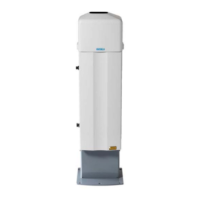Chapter 5 ________________________________________________________________ Operation
VAISALA_______________________________________________________________________ 79
The transmission time and size is the following:
0.18 s at 2 400 bps (10-bit char.)
10.6 Kbytes/h, 253 Kbytes/d, 7.6 Mbytes/mo. at 4 msg./min.,
uncompressed.
Message interpretation:
1ST LINE
Example: CTA2010
where
= Start-of-Heading character
CT = Ceilometers' identification string; always CT
A = Unit number 0 ... 9, A ... Z
20 = Software level id 00 ... 99
1 = Message number; this message is always = 1
0 = Spare character for future subclasses of message
= Start-of-Text Character
2ND LINE
Example: 30 01230 12340 23450 FEDCBA98
Second line of CT25K data message No. 1 is identical to that of CL31
data message No. 1 (see section CL31 Data Messages No. 1 and 2 on
page 63), except for the status bit string, which is 4-byte hex coded. The
status bit string is coded as follows:
where
FEDC
BA98
= Alarm (A), Warning (W), and internal status information. Each character is a
hexadecimal representation of four bits, that is, values between 0 and 9 are
presented with respective numbers and values 10, 11, 12, 13, 14, and 15 are
presented with letters A, B, C, D, E, and F respectively. As each character
represents the sum of four individual bits, the total number of bits is 32 (b00-
b31), with the following breakdown and interpretation:
F: b31 (8000 0000) Transmitter shut-off (Laser temperature high.)
(A)
b30 (4000 0000) Transmitter failure (A)
b29 (2000 0000) Receiver or coaxial cable failure (A)
b28 (1000 0000) Engine, voltage or memory failure (A)
E: b27 (0800 0000) (spare) (A)
b26 (0400 0000) (spare) (A)
b25 (0200 0000) (spare) (A)
b24 (0100 0000) (spare) (A)
D: b23 (0080 0000) Window contaminated (W)

